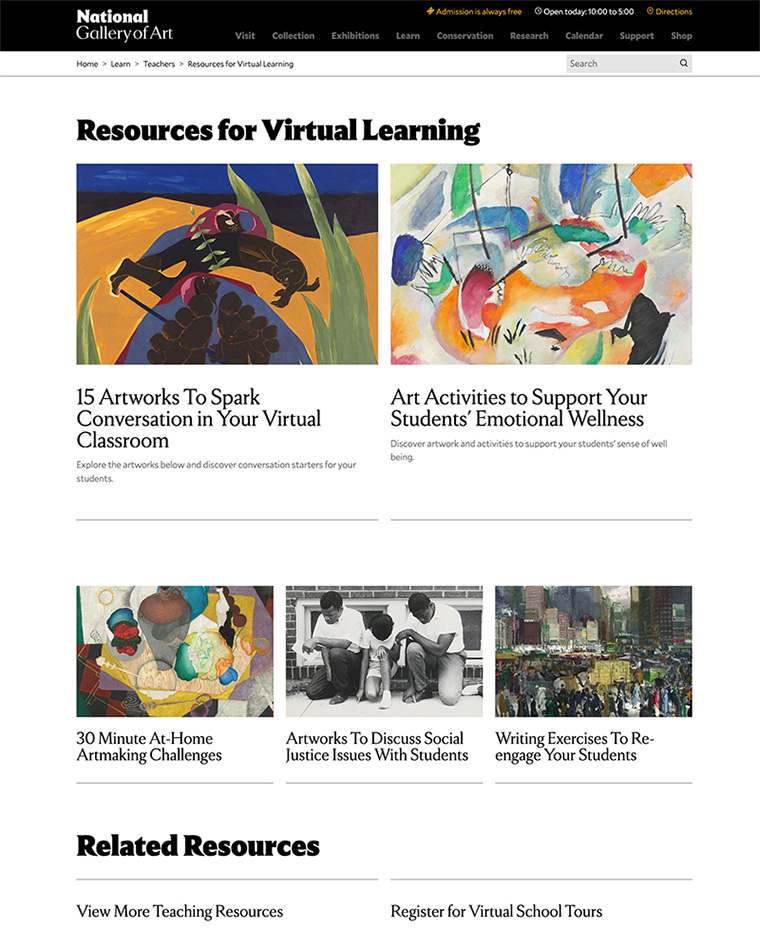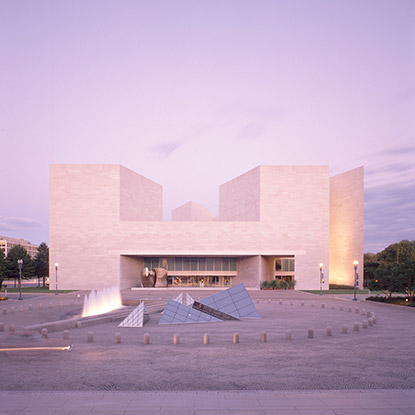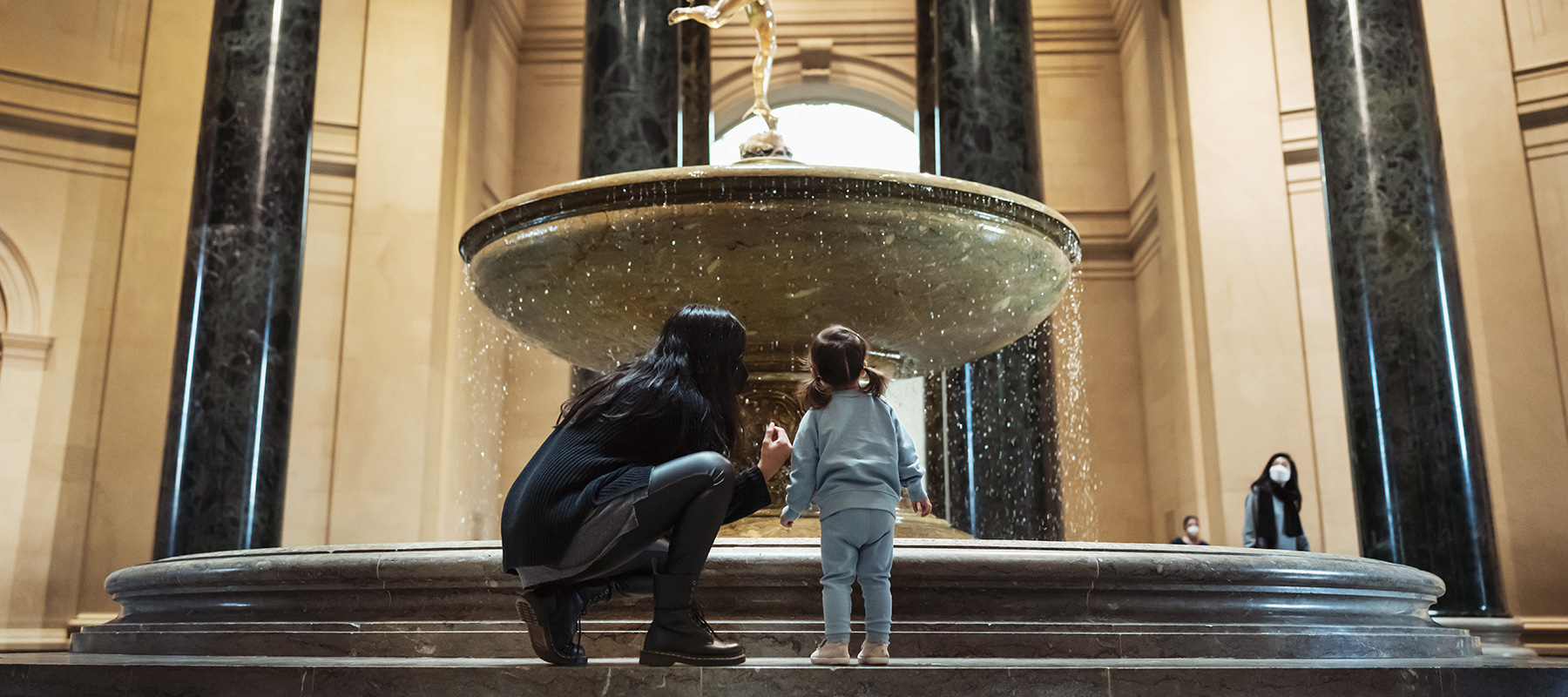In response to the pandemic and in an effort to promote the health and safety of staff, visitors, and volunteers, the National Gallery closed to the public on November 20, 2020. During the temporary closure, on-site public programming and events, films, concerts, and talks were canceled or postponed. Staff transitioned to a maximum telework posture, and we vastly increased our digital presence to serve the public. Website traffic increased more than 36 percent since fiscal year 2019. The Sculpture Garden reopened with visitor capacity limits in place on February 14, 2021, followed by portions of the West Building and East Building in accordance with social distancing and safety protocols. Remarkably, the National Gallery was still able to welcome 1,042,900 visitors in fiscal year 2021.
A Reimagined Brand and a Reinvigorated Mission
What does art tell us about ourselves? This short video follows the journey of the National Gallery: growing from a generous gift, eighty years ago, into a place that helps us imagine a different kind of future, together.
This year, we introduced our new brand and visual identity, which are built on our revived mission statement: the National Gallery serves the nation by welcoming all people to explore and experience art, creativity, and our shared humanity. While our core purpose has not changed, its reframing focuses on the impact we hope to make. Our new brand is an essential element of our growth. The emphasis on National in our logo reflects our renewed commitment to serve as the nation’s art museum. And our new color palette represents the institution we aspire to be: energetic, vibrant, and diverse. We want the brand to help unite us not just in our communications, but in our commitment to becoming more open, inclusive, and welcoming to everyone. We the people belong here, at the museum of the nation and for the people.
Digital Resources to Support Educators

Museum educators created new resources to support families, K – 12 teachers, and other educators during the pandemic.
Virtual classrooms became a normal part of the everyday lives of many teachers, students, and parents during the pandemic. World-class teaching resources were available on the National Gallery’s website prior to the pandemic, but in 2020 and 2021 access to these resources became even more crucial for educators and families navigating temporary school closures. During fiscal year 2021, more than half a million unique users accessed education resources and downloaded lesson plans from the National Gallery’s website. Incorporating works of art into the classroom—whether virtual or in-person—can spark engagement, support critical thinking, and foster social-emotional wellness in both students and educators. The National Gallery’s resources support a vast community of educators and are available free of charge, 365 days a year.
Faith Ringgold

Faith Ringgold, The American People Series #18: The Flag is Bleeding, 1967, oil on canvas, National Gallery of Art, Washington, Gift of Glenstone Foundation and Patrons’ Permanent Fund, 2021.28.1
The National Gallery of Art acquired The American People Series #18: The Flag is Bleeding (1967), its first painting by Faith Ringgold (b. 1930). This pivotal work by a leading figure of contemporary art exemplifies the artist’s skill in using art as a vehicle to question the social dynamics of race, gender, and power. As a visual storyteller, Ringgold is known for her thought-provoking depictions of the difficult realities of the American experience. The painting was acquired with funds gifted by Glenstone Foundation and from the Patrons’ Permanent Fund.
For Ringgold, the American flag is a potent and powerful symbol. She has said, “The flag is the only truly subversive and revolutionary abstraction one can paint.” This painting is part of her first fully developed body of work, The American People Series (1963–1967). Considered to be among her most powerful series, it features unflinching and often puzzling depictions of the racial tensions and political divisions in the United States during the 1960s.
Artist Projects: Sarah Cain, Avish Khebrehzadeh, Kay Rosen
Sarah Cain talks about how fierce feminism and humor infuse My favorite season is the fall of the patriarchy.
Sarah Cain, Avish Khebrehzadeh, and Kay Rosen were commissioned to create special site-responsive installations for the East Building while it underwent a skylight replacement and other renovations. The three artists—all known for making works in temporary sites or architectural spaces—took advantage of construction walls and transformed otherwise empty areas into stimulating environments. Their imaginative and problem-solving talents provided innovative solutions that enlivened the building while works of art from the permanent collection were removed or covered. Through their involvement in Artist Projects, Cain, Khebrehzadeh, and Rosen introduced new ways to experience familiar spaces of the East Building.
Jan Brueghel the Elder

Jan Brueghel the Elder, Wooded Landscape with Travelers, 1610, oil on panel, National Gallery of Art, Washington, The Lee and Juliet Folger Fund, 2020.26.1
The National Gallery of Art acquired Wooded Landscape with Travelers (1610), an exquisite example of one of Jan Brueghel the Elder’s (1568–1625) most popular landscape themes: a well-traveled road winding through woodland. This painting simultaneously reflects the traditional compositional structure developed by 16th-century Netherlandish artists and, through its increased naturalism and celebration of the everyday, prefigures subsequent developments in landscape painting.
This painting was previously owned by Max Stern (1904–1987) of the Galerie Stern, Düsseldorf, before he fled the Nazi regime in December 1937 and emigrated to Canada by way of England. Before the National Gallery acquired the painting, the Swiss art dealer David Koetser (of David Koetser Gallery) and the Dr. & Mrs. Max Stern Foundation, Canada, the heir to Stern’s estate, reached a friendly settlement resolving any and all of the foundation’s claims to the painting. The National Gallery acquired the painting from Koetser through the generosity of The Lee and Juliet Folger Fund. The National Gallery is grateful for the careful provenance research conducted on this work by the Zentralinstitut für Kunstgeschichte, Munich.
John Wilmerding Symposium on American Art and Community Celebration: Alma Thomas
In this episode of Your New Favorite Artist, learn about Alma Thomas’s extraordinary life, and enjoy her colorful, joyful art.
The National Gallery’s 2021 John Wilmerding Symposium on American Art and Community Celebration were featured as part of an expansive citywide celebration honoring the late pioneering artist on the 130th anniversary of her birth. Featuring a virtual introduction by former First Lady Michelle Obama, the John Wilmerding Symposium on American Art kicked off the festivities. Hosted virtually, the symposium brought together noted scholars, artists, and curators to discuss Alma Thomas’s life and legacy through virtual conversations. Following the symposium, the National Gallery of Art hosted an in-person, on-site community celebration honoring Thomas.
Made possible by a grant from the Alice L. Walton Foundation.
Works from the Souls Grown Deep Foundation

Mary Lee Bendolph, Blocks and Strips, 2002, wool, cotton, and corduroy, National Gallery of Art, Washington, Patrons’ Permanent Fund and Gift of the Souls Grown Deep Foundation, 2020.28.1
The National Gallery of Art acquired 40 works from the Souls Grown Deep Foundation by 21 African American artists from the southern United States. The acquisition is made possible through the generosity of the Souls Grown Deep Foundation in addition to funds from the Patrons’ Permanent Fund.
The acquisition includes nine quilts made by artists from Gee’s Bend—a small African American community along the Alabama River—where artists have created quilt masterpieces from recycled clothes and dresses, feed sacks, and fabric remnants for the last one hundred years. Mary Lee Bendolph (b. 1935), one of the best known and most revered quiltmakers, uses complex geometric and color structures in an ingenious elaboration on the traditional practice of quilting in strips and blocks. In a quilt she made in 2002, rectangles of brown wool and blue denim are juxtaposed with brightly colored strips and squares that play off the structural framework of the "Housetop" pattern, a conventional design of concentric squares that is popular among the quiltmakers of Gee’s Bend. According to Bendolph, her works draw inspiration from the colors, shapes, and patterns of the world around her, resulting in designs that are abstract remappings of the visual environment.
Podcast Series Sound Thoughts on Art

National Gallery of Art, East Building photo by Dennis Brack

Vijay Iyer photo by Monica Jane Frisell
The pandemic-related closure of the National Gallery of Art in 2020 caused the temporary suspension of the long-standing Sunday concert series. During this time, the museum launched the podcast series Sound Thoughts on Art, which explores the relationship between visual art and music. Hosted by musician and journalist Celeste Headlee, each episode features a conversation with a musician who has chosen a work of art from the National Gallery’s collection and responded to it using sound. The first season features conversations with composer-pianist Vijay Iyer on I. M. Pei’s East Building, hip-hop artist Jasiri X on Kerry James Marshall’s woodcut Untitled (Man), composer and instrumentalist Bora Yoon on Nam June Paik’s video sculpture Ommah, and many more. Headlee also talks with museum experts, who describe the works and provide art historical context. Sound Thoughts on Art tells the stories of how we experience art and how it connects us.
Christopher Wool

Christopher Wool, Untitled, 2017, bronze, copper-plated stainless steel, and stainless steel, National Gallery of Art, Washington, Gift of Christopher Wool in memory of Dr. Glorye Wool and Dr. Ira Wool and the Patrons' Permanent Fund, 2021.12.1
The National Gallery acquired its first sculpture by Christopher Wool (b. 1955). Untitled (2017) is on view in the Sculpture Garden. The work’s serpentine lines are a careful compositional choice that reflects Wool’s recent gestural paintings.
For more than 30 years, Wool has pursued his career as a painter with focus and intensity, working almost entirely in black and white, reflecting the urban grit of his New York surroundings by using either large stenciled words or by exploring abstract lines, shapes, and patterns. Since 2007 Wool has been living part-time in Marfa, Texas, where he began to make sculptures inspired by tangles of old fencing and hay-baling wire that he finds on his property. He uses the wire to create small maquettes, some of which are then subjected to an elaborate process of 3D-scanning, computer-aided enlargement, and fabrication using metal alloys engineered for structural integrity.
Special Exhibitions and Virtual Tours
Faced with temporary closures of the National Gallery during the pandemic, staff created dynamic virtual tours, such as this presentation of Raphael and His Circle, that allow visitors to zoom in on the works, click on the different-colored dots to read wall texts, see artist biographies, watch related video clips, and more.
Responding to the challenges of the moment, staff continued to make art more accessible to the public through digital programs and innovations. Virtual tours of special exhibitions True to Nature: Open-Air Painting in Europe, 1780–1870, Degas at the Opéra, Raphael and His Circle (pictured above), and Lynda Benglis extended the reach of the institution both physically and temporally, allowing visitors across the world to explore the art from the comfort of their homes and continue enjoying the presentations in perpetuity.
Conversations: Carrie Mae Weems and The Shaw 54th Regiment Memorial

A detail of Augustus Saint-Gaudens’s The Shaw 54th Regiment Memorial (at left) facing a detail of Carrie Mae Weems’s Untitled (at right); Augustus Saint-Gaudens, The Shaw 54th Regiment Memorial, 1900, patinated plaster, U.S. Department of the Interior, National Park Service, Saint-Gaudens National Historic Park, Cornish, New Hampshire, on long-term loan to the National Gallery of Art; Carrie Mae Weems, Untitled, 1996, printed 2020, 7 inkjet prints with sandblasted text on glass in wood frames, National Gallery of Art, Washington, Patrons’ Permanent Fund, 2020.96.1.a–g
Augustus Saint-Gaudens’s The Shaw 54th Regiment Memorial and Carrie Mae Weems’s Untitled speak to our nation’s struggle to achieve racial equity and to the strength and sacrifice of those who have continued to wage the battle. The heroism of the 54th Massachusetts Regiment, one of the first African American regiments formed in the North during the Civil War, has inspired artists for more than 150 years. This fiscal year, the National Gallery of Art acquired Weems's seven-part series of inkjet prints—each a reproduction of a historic photograph and each framed with sandblasted text on glass—and installed it facing Saint-Gaudens’s sculpture. Weems layers text and images to center African American perspectives, constructing a nuanced history that speaks of racial pride, resilience, sacrifice, and determination. In the late 19th century, Saint-Gaudens crafted his memorial honoring Colonel Robert Gould Shaw and the 54th Regiment, depicting their 1863 march through the streets of Boston on their way to war. The bronze version of the sculpture was installed on Boston Common in 1897. Saint-Gaudens continued to work on a plaster version of the memorial, now on view at the National Gallery. Hailed as one of the finest examples of 19th-century American sculpture, the memorial is celebrated for its sensitive rendition of the soldiers. One hundred years after the completion of the sculpture, Weems incorporated images of the memorial into her series of photographs, in a testament to its lasting power. Her work commemorates another march—that of African Americans streaming north from the Jim Crow South during the Great Migration—and celebrates the rich and vital history of African American culture.
